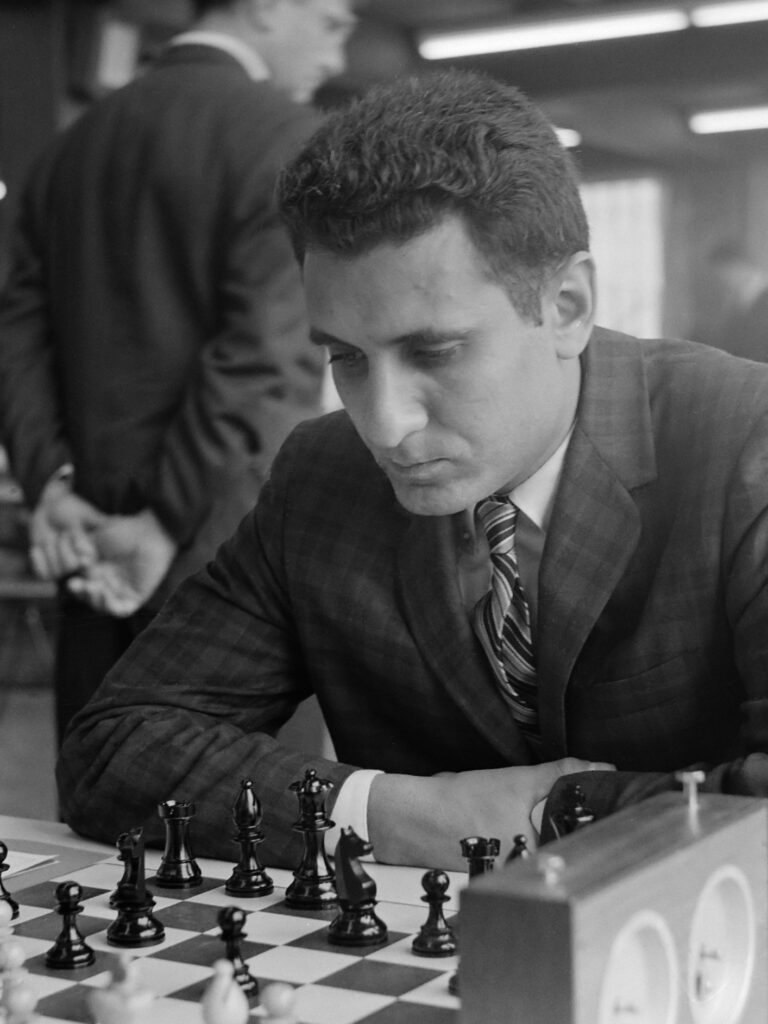Larry Evans was just 16 when he wrote his first book – a self-published monograph on the great Vienna tournament of 1922. Some of the analysis is a little wayward, but it’s still a remarkable achievement
Michael Healey
This season I have been mainly losing to people younger than myself. Other people as well, but it’s the youngsters doing the most damage. In revenge, I felt the need to savage a book written by a teenager.
In 1948 Larry Evans, aged just 16, was already a strong player. In three years he would be US champion, then go on to become an IM, a GM, US champion a further four times, and a second to Bobby Fischer. He would also become one of the most celebrated chess columnists and writers, famously co-authoring Fischer’s My 60 Memorable Games (which I still have not read).
As part of his development, the teenager not only discovered the 1922 Vienna tournament‘s scores, but took it upon himself to annotate each of the 103 games, and then self-publish the result. At 16! As Evans later admitted, “Youth is so presumptuous!” Sixty-two years later, he was asked to review his first work for a new edition of Vienna 1922, with computer assistance, sadly dying before the result was published. Thus this is both Evans’ first and last book – an alpha and omega one might say.

Vienna 1922 was a 15-player all-play-all tournament featuring a lot of big names, though lacking Capablanca and Lasker, who had contested the world championship the previous year. The field was as follows, with Chessmetrics December 1921 world ranking in brackets: Alekhine (3); Rubinstein (4); Tartakower (6); Tarrasch (7); Bogoljubow (10); Spielmann (11); Maroczy (12); Réti (13); Grünfeld (20); Sämisch (23). Bogoljubow and Rubinstein were perennial world championship contenders; Alekhine would succeed to the title in 1927. Some other names may also ring bells!
Completing the field were local bunnies Sándor Takács, Heinrich Wolf, Imre König, Hans Kmoch and Vladimir Vuković. Kmoch and Vuković went on to become better known as chess writers. Kmoch’s most notable book is Pawn Power in Chess, published in 1956, while Vuković produced two of the most famous chess books of all time – The Art of Attack in Chess (1963) and The Chess Sacrifice (1968).
In Vienna 1922, Evans’s comments are pithy, but usually humorous and accurate in equal measure. Each round is given a succinct summary, and each game a brief prologue. So what happened? Here is the scoretable:

This was to be Rubinstein’s last great hurrah. He won five in a row between rounds 10 and 14, and went undefeated all tournament, but was clearly leading a charmed life in some games. Tartakower was a deserved second, hunted down after a start of 6.5/7. Third was … Wolf?! Indeed, Wolf led the tournament in round 10, only to receive 0 from the next two games. Though several games from this tournament made his own best games collection, Alekhine lost a whole three games, despite benefiting from a bye against Spielmann, who missed the last two rounds due to illness. It is quite clear that König and Kmoch suffered, even when their games were looking promising, and sought out draws whenever possible. Neither won a game. Maroczy had a very solid tournament, only losing one game.
Whilst going through the book I realised the drama of the tournament wasn’t coming across very well, so I made my own progressive (if slightly messy) scoretable.

Here I discovered one issue with the book: several round summaries feature the wrong match pairings and results. The table I constructed demonstrated just how well Tarrasch had finished (six wins and two draws in the second half of the tournament). In round 10 he defeated Réti with a lovely king march.
34. Kh2 Nd6 35. Rg7+ Kh8 36. Rd7 Nb5 37. Kg3 Nxc3 38. Kf4 Nb5 39. Ke5 Re8 40. Kf6. Black resigns. The plan is Kf7 and Bg7#. If Rg8 Kf7 and the threat of Rd8 is game-ending.
The openings played are testament to their era and the influence of “hypermodern” ideas. Because these ideas were new, openings can look inaccurate or overindulgent to modern eyes. However, the differences in strength are also a factor. Weaker players strive for drawish lines; stronger players play some slightly fishy stuff. For this reason, many of the most entertaining games are those against König and Kmoch, whom everyone was clearly desperate to dispatch. This was how Rudolf Spielmann, with Black, did the job against Kmoch in round 4.
This was not the only game where I had cause to doubt the teenager/septuagenarian’s commentary. In round 9, Kmoch was again the victim of a crazed stronger player, Ernst Grünfeld:
As the tournament progressed I found myself really rooting for Kmoch, only to be disappointed each time. The summary before Vuković-Kmoch pretty much covered being a Kmoch fan (“Black hangs his queen!”). I genuinely bashed my head into the table.
There were a number of blunders throughout – possibly because it was a long tournament, but more likely because back then they didn’t register thousands upon thousands of tactical puzzles and tomes of theory. They had to reason things out themselves, without a bank of patterns and tricks. Sometimes it’s utter nonsense, as in this game between Vuković and Spielmann.
The positional chess can be quite impressive though, as in the following game between poor old Kmoch and Siegbert Tarrasch.
Certainly, as a disciple of chaos myself, I didn’t really trust young Evans’s nous in the crazier positions. Which was a lesson in itself: given most chess books these days are written by grandmasters with supercomputers, it’s useful to be able to challenge what you’re being told, and sometimes find out you’re actually correct. Sometimes.
As you might expect from conversion of an old descriptive book without diagrams to algebraic with plentiful diagrams, there are regular typos; these don’t detract from the games though. In all seriousness, to achieve what he did in this work is quite astonishing. Evans the teenager found the time, determination and sheer cojones to analyse games from the top tier of chess a mere 26 years before – games by players who, he admits, were at that stage all stronger than he was. Not only did he contribute to chess scholarship in the process, but he protected chess legacy and brought obscure games to a wider audience:
“My main reason for writing in 1948,” Evans said, “was to preserve the games which were then largely unavailable except for a handful of collectors.” It is little wonder he went on to be so beloved by chessplayers in America, and around the world.
